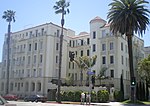Palisades Park (Santa Monica)
Landmarks in Santa Monica, CaliforniaParks in Los Angeles County, CaliforniaSanta Monica, CaliforniaTourist attractions in Santa Monica, CaliforniaUse mdy dates from August 2020

Palisades Park is a 26.4-acre (10.7 ha) park in Santa Monica, California. The park is located along a 1.6-mile (2.6 km) section of Ocean Avenue on top of an uplifted unconsolidated sedimentary coastal Quaternary terrace with exposed bluffs, offering views of both the Pacific Ocean and the coastal mountains.
Excerpt from the Wikipedia article Palisades Park (Santa Monica) (License: CC BY-SA 3.0, Authors, Images).Palisades Park (Santa Monica)
Ocean Avenue, Santa Monica
Geographical coordinates (GPS) Address Nearby Places Show on map
Geographical coordinates (GPS)
| Latitude | Longitude |
|---|---|
| N 34.0231 ° | E -118.5095 ° |
Address
Ocean Avenue
90401 Santa Monica
California, United States
Open on Google Maps









